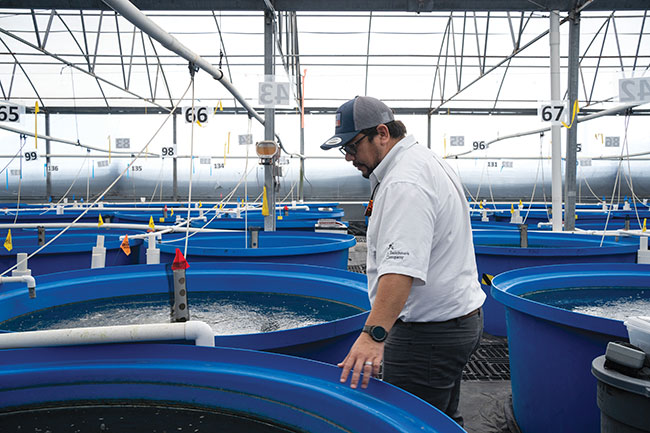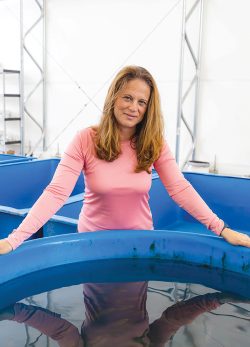
Features
Breeding
Genetics Week
Hatchery Hack: Should you invest in your own breeding program?
April 17, 2024 By Nicole Kirchhoff
 The Benchmark Genetics USA facility runs tilapia breeding programs for farms around the world.
(Photo: Jean Ko Din, Hatchery International)
The Benchmark Genetics USA facility runs tilapia breeding programs for farms around the world.
(Photo: Jean Ko Din, Hatchery International) It is no secret that breeding has been the key to a worldwide aquaculture boom, especially for salmon.
Aquaculture species can now grow faster, are more disease-resistant, use fewer resources, and are potentially healthier than their wild counterparts.
One of the most important gains is economic viability, as a farm can increase production yields. But for many species and many farms, on-farm breeding programs are drastically underutilized. I would argue that a breeding program is one of the most important tools in an aquaculture business tool belt.
What is selective breeding?
Selective breeding occurs when humans select which individuals of a larger population will produce offspring, usually to enhance one or more traits. This is different from natural selection, where environmental pressures decide which traits will survive in subsequent generations.
Selective breeding has been used for thousands of years to produce high-yielding, disease-resistant, and good-tasting terrestrial crops such as wheat, corn, rice, cows, and chickens. In broodstock management, “wild” are those broods obtained directly from the wild, held in captivity, and spawned. “Captives” are those selected for one to two generations. “Domesticated” are those selectively bred for three or more generations.
The advantages
Since the 1990s, the growth rate of tilapia has increased 350 per cent, salmon has increased 270 per cent and shrimp 240 per cent. But growth is only one of many variables. Some species were not even able to be aquacultured without selective breeding.
For example, striped bass took many generations before they would effectively eat and survive in captivity. While farmers may primarily select for growth, disease resistance, or other easily measured traits, many other “passive” traits are also selected such as willingness to accept artificial feeds, tolerate handling and crowding stress, ability to mature and reproduce in captivity, etc. The result is animals that can far outperform their wild or captive counterparts in commercial aquaculture settings.
“We often only highlight the biological gains selective breeding programs provide without the added reminder of the downstream effect, improved economic viability of the farm,” said Megan Sorby, CEO of Pine Island Redfish and former operations manager of Kingfish Maine.
“This is particularly important in the growth of the RAS sector, where every efficiency must be realized to overcome the upfront capital expense of the facility as well as the ongoing big three costs – feed, energy, and labour… In just a few generations, you can experience a doubling of growth rate and improved feed conversion, which tremendously improves the financial trajectory of the RAS farm.”
You farm set-up
One of the many myths is that a breeding program takes a considerable amount of investment. Organization and records, yes. But most of the time, it only requires a farm to select a proportion of the fastest growers or those with the best marketable traits such as coloration or market yield, at the end of each production cycle as breeders for the next generation.
Even a small investment made into a breeding program can quickly pay for itself. A hatchery that can demonstrate superior seed, can also ask for a higher market price. A growout operation can produce greater yield for less time and resources.
Dr. Ben Reading, director of the North Carolina State’s Pamlico Aquaculture Field Laboratory, has selectively bred striped bass for over 30 years to improve growth rates, stress tolerance, and disease resistance, and to optimize feed efficiency. He has observed 15 to 30 per cent better growth with each selected generation and after five generations he had fish that grew in captivity twice as fast.
“The easiest trait to look for is growth to market. A farm is growing out their product to market anyway, so selecting the top performers at harvest isn’t an expensive extra step. You don’t even need to hold broodstock between spawning seasons. You can produce offspring from the best producers as soon as they can reproduce and then send those parents on to market,” said Reading.
“In addition, every farm has a catastrophe at some point, whether it be a low DO or disease event. Breed those survivors and a farm already has a potentially hardier crop. Often it only takes three generations to see large gains in yield. Selecting on your farm also has the increased benefit of producing strains that are best suited for your unique conditions.”
While it may be easy to select the top performers each production cycle, a farmer must, however, ensure they are breeding from a variable enough genetic stock so as not to create inbreeding.
The FAO has a genetic rule of thumb: breeding from 50 females and 50 males should maintain sufficient genetic diversity. This may be easy for highly fecund species but may be far more difficult for those species that may produce small numbers of offspring each season.
Third-party breeding
Genomic technologies have created opportunities to make production gains at a much faster pace and select for traits not easily seen. For example, sequenced genomes of individuals can be data mined to find those that may contain disease resistance or superior environmental tolerance, not easily seen with the human eye.
And even further, genetic engineering, common for terrestrial crops, is showing up in species like AquaBounty’s salmon. This has created business opportunities for third parties such as Benchmark Genetics to specialize in creating a series of superior-performing seed lines for salmon. (I.e. salmon ova)
An argument can be made, if you are to be economically competitive in today’s business landscape and produce salmon, tilapia, shrimp, sea bream, striped bass or any other extensively bred aquaculture species, you must utilize third-party seed.
Reinventing the wheel is just far too costly in both time and IP to catch up with the market. Some of this superior seed is controlled and produced by private companies and some is organized by cooperatives held at government or research institutions. As a business owner, it is important to do your research to get the best seed for your situation. (I.e. environment, culture system, price, market, etc.)
If you are producing a newer species or one where a third-party breeding program does not exist, you can still benefit from some of these new technological leaps. The cost of obtaining genetic snips from your best producers and mining them for other less obvious superior traits is declining every year.
In addition, many governments have recognized the high return on investment of creating and managing genetic breeding programs at government or academic facilities such as the United States Department of Agriculture ARS labs, Virginia Institute of Marine Science, and Cooperatives such as Dr. Reading’s Striper Hub housed at N.C. State.
It is worthwhile contacting your local government or academic institution to ask about current offerings or opportunities to organize your own program. And as always, make sure you are following the regulations, as in some locations or culture systems you may not be able to use selectively bred lines of seed.
Whether your farm starts its breeding program or invests in seed from selectively bred lines, the gains from superior-bred aquaculture products are many.

(Photo: Nickolas Sargent, Sargent Photography)
Nicole Kirchhoff is the owner of Live Advantage Bait LLC (www.liveadvantagebait.com), a wholesaler of warmwater marine fish, fingerlings, and eggs for baitfish and foodfish growout, research, and restoration located in Florida, USA. Kirchhoff has a PhD in Aquatic Animal Health and was Hatchery International’s Top 10 Under 40 in 2022.
Print this page
Advertisement
- Chinese herbs mixture boosts abalone resistance vs. heat stress
- Shrimp Summit to address labour exploitation in India





